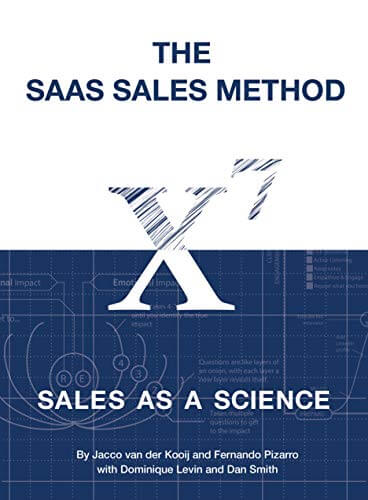The SaaS Sales Method: Sales As a Science (Sales Blueprints Book 1)
Jacco van der Kooij, Fernando Pizarro, Dominique Levin, Dan Smith

In a modern recurring revenue business it is impossible to scale without treating sales as a science. In this first book of the Sales Blueprints series, Jacco Van Der Kooij and Fernando Pizarro break down the science of sales into its basic elements.
Unlike any book before it, The SaaS Sales Method exposes the math the underpins each stage in revenue production, from marketing, to sales, to customer success, and infers how revenue leaders should structure their processes, organizations, and training in each.
By linking all three functions, The SaaS Sales Method provides a framework for the modern revenue leader to understand and improve their entire system, shifting from what the authors call a superstar culture to a science culture in the process.
While subsequent books in the series go into depth on the specifics of each revenue function and the skills needed to succeed in each, The SaaS Sales Method is the glue that holds the entire approach together.
Key Summary
The SaaS Sales Method is a guidebook on how to make sales in the Software as a Service (SaaS) industry. The book is designed to help salespeople learn the key steps of a sales process that they can use to close deals in the SaaS industry.
The book outlines a step-by-step sales process for SaaS salespeople, beginning with prospecting and moving through the close of a deal.
Snider emphasizes the importance of building relationships with customers and understanding their specific needs and pain points.
The book also covers how to deal with objections, how to negotiate pricing, and how to handle post-sale follow-up.
Throughout the book, Snider emphasizes the importance of using data and analytics to inform sales strategies and measure success.
Takeaways
1. Begin the sales process with prospecting to identify and qualify leads.
2. Build relationships with customers by understanding their needs and pain points.
3. Use data and analytics to inform sales strategies and measure success.
4. Use storytelling techniques to effectively communicate the value of your product.
5. Be prepared to deal with objections and effectively handle them.
6. Negotiate pricing effectively and understand the buyer’s budget and decision-making process.
7. Foster trust and transparency with your customers.
8. Use post-sale follow-up to maintain customer satisfaction and build long-term relationships.
9. Utilize technology and tools to streamline the sales process and increase efficiency.
10. Continuously evaluate and refine your sales process to drive growth and improve results.